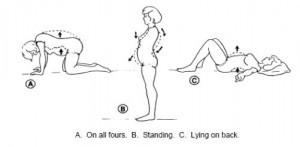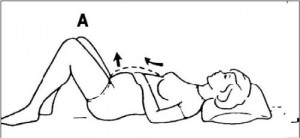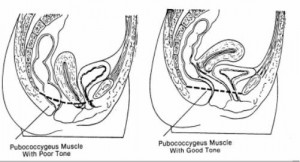a. Prenatal exercises promote comfort and maintain or increase muscle tone.
Factors that determine the type and amount of exercise recommended depends on the individual’s, need, the patient’s general physical condition during pregnancy, and the current stage of pregnancy.
b. Specific prenatal exercises includes tailor sitting, pelvic rocking, abdominal muscle contractions, Kegel exercise, and squatting.
(1) Tailor sitting (see figure 7-2). This exercise stretches the perineal muscles and strengthens the thigh muscles. The patient should:
(a) Sit flat on the floor with legs outstretched; knees are gently pushed to the floor until the perineal muscles begin to stretch.
(b) Hold this position for increased amounts of time each time performed.

(2) Pelvic rocking (see figure 7-3). This exercise stretches the back muscles and helps to alleviate backache. The patient should:
(a) Get on all fours by hollowing the back and then arching it upward to form a mound. This may also be done by lying on her back or standing up.
(b) Thrust back outward with buttocks tucked under. Hold for at least 3 seconds and release. Repeat 5 times.

(3) Abdominal muscle contractions (see figure 7-4). This exercise strengthens the abdominal muscles, which assist in effective pushing during the second stage of labor, and helps regain abdominal shape following delivery. The patient should:
(a) Contract and relax the muscles of the abdomen.
(b) Repeat as often as desired and gradually increase the time held.

(4) Squatting (see figure 7-5). The exercise stretches the perineal muscles. The patient must squat and keep her feet flat on the floor. Do this 15 minutes per day.
NOTE: The perineum is the skin-covered muscular area between the vaginal opening and the anus.
(5) Kegel exercise-pelvic floor contractions (see figure 7-6). This exercise strengthens the muscles of the perineal floor. The patient should alternate between tightening and relaxing the perineal muscles. This can be done at any time and should be repeated 75 to 100 times per day.


